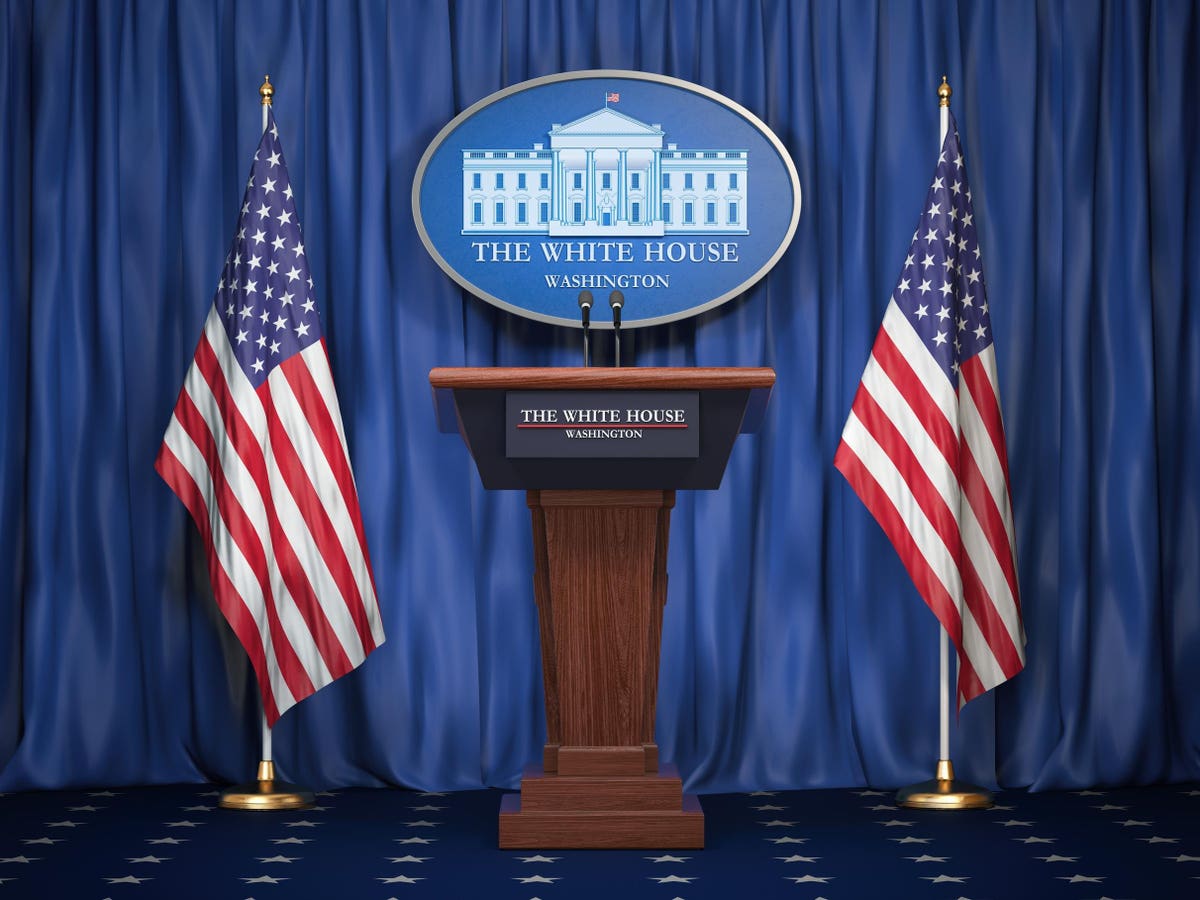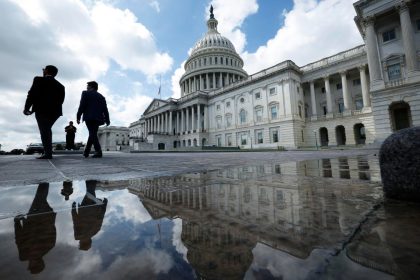The title page reads, “Mandate for Leadership, the Conservative Promise — Project 2025, Presidential Transition Project.” What follows are 920 pages of sweeping changes for the “next conservative president” to put into effect or, if not sufficiently empowered, to recommend to Congress. From abortion to veterans affairs, the anthology of 30 chapters, each by a different author, is a prepackaged game plan for the next administration to hit the ground running with a conservative wish list.
Tax reform would take place in two stages. Stage 1 “intermediate” reform would retain the basic structure of the Tax Cuts and Jobs Act but dramatically adjust its moving parts. Stage 2 “fundamental reform” would abolish individual and corporate income taxes and replace them with a consumption tax. The plan calls for the IRS budget to be cut, and as with other executive agencies, more of its top personnel would be appointed by the president.
Led by the Heritage Foundation, more than 50 conservative organizations collaborated on the Project 2025 volume. After President Joe Biden’s poor performance in the June 25 debate and the close ties between former President Donald Trump and the Heritage Foundation, the bulky tome — originally published in April 2023 — can no longer be ignored by those seeking to prepare for the future. The tax policy and tax administration changes are found mostly in Chapter 22, “Department of Treasury.”
Stage 1: Intermediate Reform
Under the intermediate plan, individuals and their employers would continue incurring a combined payroll tax of 15.3%. After a standard deduction, income tax will be incurred at 15% up to the payroll tax cap of $168,600 (adjusted for inflation) and at 30% for income that exceeds that amount. Capital gains and qualified dividends would be indexed for inflation and taxed at 15%.
“Most deductions, credits and exclusions” would be repealed, with deductions for state and local taxes and educational expenses being specifically called out. The 3.8% net investment income tax would be repealed. Combined, the payroll tax and income tax start to look like a flat tax with a 30% rate.
Given Project 2025’s emphasis on promoting small business, it is strange that the 20% deduction for passthrough businesses scheduled to expire at the end of 2025 is not mentioned.
Universal savings accounts would be established, allowing all individuals to contribute up to $15,000 annually (indexed for inflation) in after-tax dollars and withdraw funds tax free at any time or for any reason. Basically, the accounts are Roth IRAs without restrictions. Employers could deduct no more than $12,000 of most nonwage benefits, including employer-sponsored health insurance, per employee each year.
However, retirement account contributions and a share of health savings account contributions would be exempt from the cap. Excluded from the limitations are tax-deferred retirement accounts such as traditional IRAs and section 401(k) plans. The authors would not index the $12,000 limit for inflation, and “to fund pro-growth tax cuts,” they suggest that lawmakers phase down the limitation.
The estate and gift tax rate would be set at no higher than 20 percent, and the temporary increase in the exemption amount from $5.5 million to $12.9 million (adjusted for inflation) introduced in the TCJA would be made permanent.
The corporate tax rate would be reduced from 21% to 18%. Capital expenditures would be written off in the first year. It is not stated whether structures and other property that have depreciable lives of more than 20 years would be denied expensing, as they are under today’s law.
The authors assert that the corporate tax is “the most damaging tax in the U.S. tax system.” Most economists would agree. Also, the authors assert that the “primary burden” of the corporation tax falls on workers. Most economists wouldn’t agree. The Joint Committee on Taxation, for example, assigns 75% of the burden of the corporate tax to capital owners and 25% to labor.
The intermediate tax reform would basically repeal the Inflation Reduction Act of 2022, including the corporate alternative minimum tax and the tax on stock buybacks. And it would repeal the tax breaks for clean energy.
Regarding international tax, the tax rate on global intangible low-taxed income, now 10.5% (scheduled to rise to 13.125% in 2026) would be “reduced to no higher than 12.5%.” The rate on foreign-derived intangible income would be set equal to the GILTI rate. (To get a 12.5% effective rate with a statutory rate of 18%, the section 250 deduction percentage would be set at 69.44%.) The 20% haircut that applies to foreign tax credits related to GILTI would be reduced or eliminated. There is no mention of changing the expense allocation rules that under current law can reduce FTCs and impose additional U.S. tax when foreign tax is above the GILTI rate.
The authors describe the OECD as “a taxpayer-funded left-wing think tank and lobbying organization.” They urge the United States to withdraw from and end its financial support to the OECD. The same goes for the World Bank and the International Monetary Fund.
“The IMF has intervened in American policy debates,” they point out, “and has even recommended that the U.S. raise taxes.” That is true: As recently as June 27, the IMF issued a statement telling U.S. policymakers they “need to carefully consider raising indirect taxes” and “progressively increasing income taxes.” The statement specifically recommends “reinstating a more generous, refundable Child Tax Credit … and raising the income threshold for eligibility for the Earned Income Tax Credit for workers without children.”
Stage 2: Fundamental Reform
After those immediate reforms, Project 2025 urges the next president to promote fundamental tax reform, and it leaves the door wide open. Among the possibilities mentioned are a national sales tax, a business transfer tax (a subtraction method VAT), a Hall-Rabushka flat tax, and a cash flow tax. The document does not explicitly say so, but we can assume the intent is that those taxes would replace the individual and corporate income taxes — and possibly payroll taxes.
Of those four categories (and within the categories there are several variations), three collect taxes exclusively from businesses: the sales tax, business transfer tax, and cash flow tax. Those three also (in most versions) have border tax adjustments, which means that revenue from exports is excluded from the tax base and imports are subject to tax. Only the flat tax collects tax from individuals and businesses, and the flat tax shuns those border tax adjustments.
Noticeably absent from the list of consumption taxes are a credit-invoice VAT used by most other nations and an X-tax, which is a progressive consumption tax.
Trade and Tax Policy
Before the TCJA was passed in 2017, Republicans on the House Ways and Means Committee seriously considered implementing a border-adjustable destination-based cash flow tax to replace income taxes on corporations and passthrough entities. Yes, it would be a tax (tariff) on imports and tax cut (subsidy) on exports. Yes, it looks like protectionist policy. But according to standard economic principles, the dollar will appreciate and offset any tendency for the tax law to improve the trade balance.
For economists the main attraction of the DBCFT is its positive effect on capital formation (because a consumption tax would replace the corporate tax). In Chapter 26 of the Project 2025 volume, Peter Navarro, former director of the White House National Trade Council under Trump, argues for U.S. tariffs. In particular, he urges enactment of the U.S. Reciprocal Trade Act, which would allow the president to impose tariffs on goods from a foreign country at the same rate that the foreign country imposes on imports of similar U.S. goods.
The bill (H.R. 764, 116th. Cong.) had the support of 28 House Republicans in 2019, and more significantly, Trump urged its passage in his State of the Union address that year. Navarro writes:
“In summary, passage of the USRTA would go a long way toward leveling the playing field for American farmers, ranchers, manufacturers, and workers who are now forced to compete in an intrinsically unfair, unbalanced, and nonreciprocal [World Trade Organization] system. Nor is the USRTA necessarily the only possible legislative way to address this issue.”
He then describes how the DBCFT got so much attention from House Republicans immediately before passage of the TCJA. (He does not acknowledge the possibility of exchange rate appreciation.) He concludes:
“This tax — strongly opposed by American multinational corporations and big box retailers — not only would have leveled the playing field with respect to WTO rules, but also would have provided an innovative alternative to the application of tariffs. A conservative Administration might do well to look at such a tax as part of its trade agenda.” [Emphasis added.]
With protectionist trade measures being so prominent on Trump’s policy agenda, if he is elected we should not be surprised if there is renewed interest in the DBCFT. Yes, it is a long shot. The same opposition from business groups will emerge.
But if Trump is determined to pursue broad-based tariffs that are also strongly opposed by businesses, those businesses might have to choose between tariffs and a DBCFT.
Tax Administration
The plan calls for the IRS budget to be held constant in real terms (so the increase included in the Inflation Reduction Act would be rescinded). Funds and authority of the Office of the Taxpayer Advocate would be increased. The Office of Equity, Diversity, and Inclusion would be closed.
There would be a much greater emphasis on improving technology and potential expansion of funds in this area if “IT management is changed; an effective well-considered implementation plan is adopted; and serious oversight is put in place.” More of the top positions in the IRS would be held by presidential appointees.
Speaking of changes in management, many more of the top positions in the IRS would be held by presidential appointees. Adding to the commissioner and chief counsel, presidential appointees would include at a minimum the deputy commissioner for services and enforcement, the deputy commissioner for operations support, the national taxpayer advocate, and the commissioners of the Wage and Investment Division, the Large Business and International Division, the Small Business/Self-Employed Division, and the Tax-Exempt and Government Entities Division. Also, a new presidentially appointed deputy commissioner for operations support would be installed, and various senior IT managers would be replaced. All of that would be necessary because “the culture, administrative practices, and management need to change.”
Also, information reporting should be restrained. Interest on overpayments would be increased. The time limit for suing for improper collection would be extended. The Tax Court’s jurisdiction would be expanded. And there would be relief from the “most punitive penalties.”
What’s Possible? It Depends
If Trump is elected, many expect him to exercise executive power to the fullest extent. If Democrats control either house of Congress, much of his agenda requiring legislation will likely be stymied. If the Republicans gain control of the House and Senate — the odds of retaking the latter are especially strong — Trump would likely obtain passage of a great deal of his tax and spending proposals using a single budget reconciliation bill, which, instead of needing 60 votes to block a filibuster, would need only a simple majority to pass in the Senate.
But some of his policy goals that require legislation might not be included in a reconciliation bill if they produce no changes in outlays or revenue, or if any changes are merely incidental to the nonbudgetary components of the provision.
New Tax Breaks
The introduction to the Project 2025 volume states that all its authors do not share the same views. As noted, in Chapter 22 the three authors urge that most deductions and credits be repealed, including deductions for education.
But while the tax chapter urges elimination of tax expenditures, other chapters suggest selected expansion of tax expenditures. Chapter 11, “Department of Education,” endorses the proposed Educational Choice for Children Act, which would provide a tax credit to donors who contribute to nonprofit, scholarship-granting organizations that pay for private school tuition, tutoring, and instructional materials.
The bill (H.R. 532) was introduced in the House in 2023 by Rep. Adrian Smith, R-Neb., with 151 Republican cosponsors and in the Senate (S. 120) by Sen. Bill Cassidy, R-La., with 31 Republican cosponsors. Chapter 14, “Department of Health and Human Services,” proposes an expansion of the EITC for parents who help support but do not reside with their children.
Chapter 15, “Department of Urban Development and Housing,” recommends a tax credit for the renovation or repair of housing stock in rural areas. And the Chapter 22 authors themselves suggest one new tax break: They want “significant financial and tax incentives to American companies that are seeking to onshore production from Communist China to U.S. soil.”
Observations
Perhaps the most notable feature of the Project 2025 tax plans is what isn’t in them. For example, the entire document contains no proposals to reform Social Security, nor is the program ever even mentioned (except when necessary to explain other proposals). The entire document contains no proposals to reform Social Security, nor is the program ever even mentioned.
Also, there are no accompanying revenue estimates. In fact, there is no mention of revenue effects of the proposals in Chapter 22. The closest we get is a statement of tangential relevance: “The budget should be balanced by driving down federal spending while maintaining a strong national defense and not raising taxes.”
(By the way, under those constraints, balancing the budget — if current economic projections hold up and if the TCJA is extended — would require deficit reduction equal to more than 8% of GDP in 2034. Outlays for mandatory programs, excluding Social Security and nondefense discretionary spending, are projected to equal about 12% of GDP.)
It is easy to propose changes to tax law without revenue estimators looking over your shoulder. No matter the election outcome, lawmakers won’t have that luxury.
Further, there are no distribution tables. In fact, there is no discussion of distribution effects except the aforementioned assertion that most of the corporate tax burden falls on labor. With a reduction in the top individual rate, the repeal of the NII tax, and the reduction in tax rates on capital gains, qualified dividends, and the estate and gift tax, the intermediate proposal would disproportionately reduce taxes on high-income taxpayers. Concerns about vertical equity are ignored.
An Alternative Starting Point
A recent paper from the American Enterprise Institute offers two options for a simple extension of the TCJA. Option 1 (incremental) is a modified extension of the TCJA designed to further promote economic growth. Option 2 (aggressive) would make pro-growth adjustments to the design of the individual income tax and replace the corporate tax with a business transfer tax.
Sounds similar to the Project 2025 plan, yes? But no. The differences are enormous.
That’s because the plan outlined by Kyle Pomerleau and Donald Schneider — “Making the Tax Cuts and Jobs Act Permanent: Two Neutral, Pro-Growth Options for Tax Reform” — includes revenue estimates and distribution analysis. That compels the authors to make tough choices that Project 2025 evades.
A recent paper from the American Enterprise Institute offers two options for a simple extension of the TCJA. Further, both plans are estimated to be roughly distributionally neutral relative to today’s law, and both are approximately revenue neutral compared with today’s law — without any extension of the TCJA. (For option 2, that is true only in the long run.)
The authors are focused on the unrelenting rise in the federal deficit and the need to promote economic growth. The Pomerleau-Schneider plans are ambitious, but they are far more thoughtful and realistic than what has been cobbled together by Project 2025. Undoubtedly, most conservatives would prefer what the Heritage Foundation’s Project 2025 offers.
But for Republican legislators, the paper from the American Enterprise Institute is a more practical starting point. And given the estimated revenue and distributional effects, it deserves the attention of Democrats as well.
Read the full article here


















